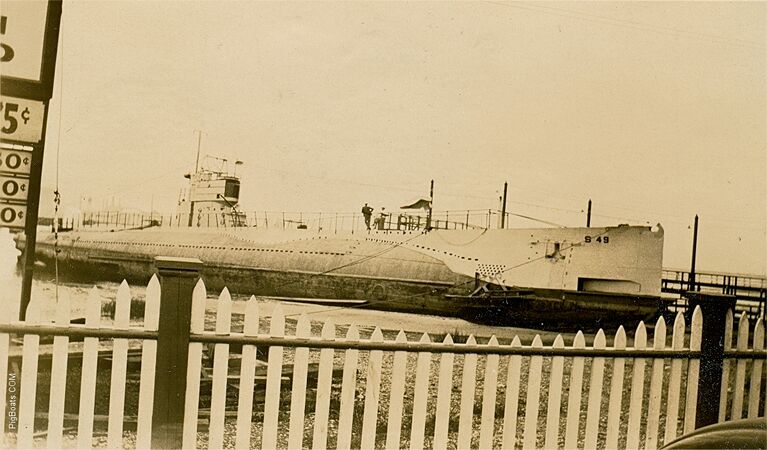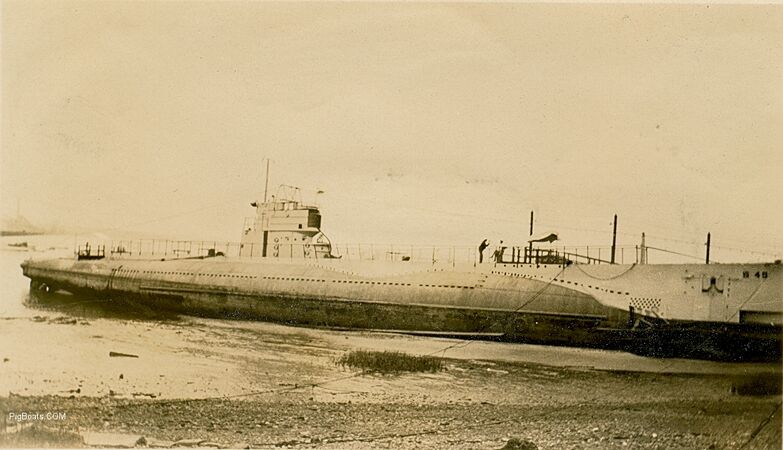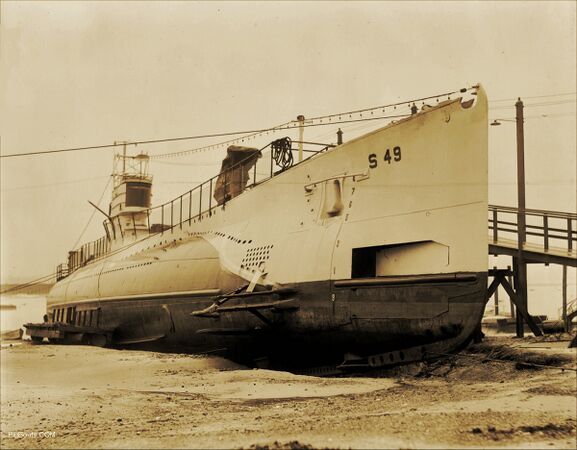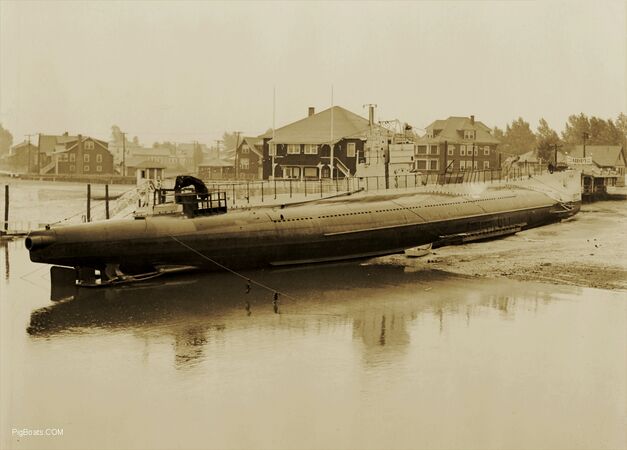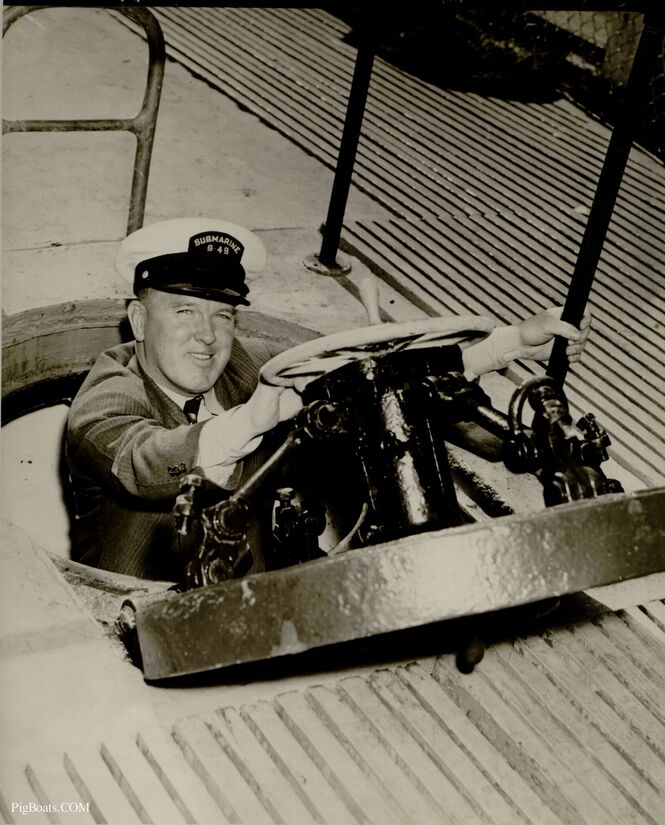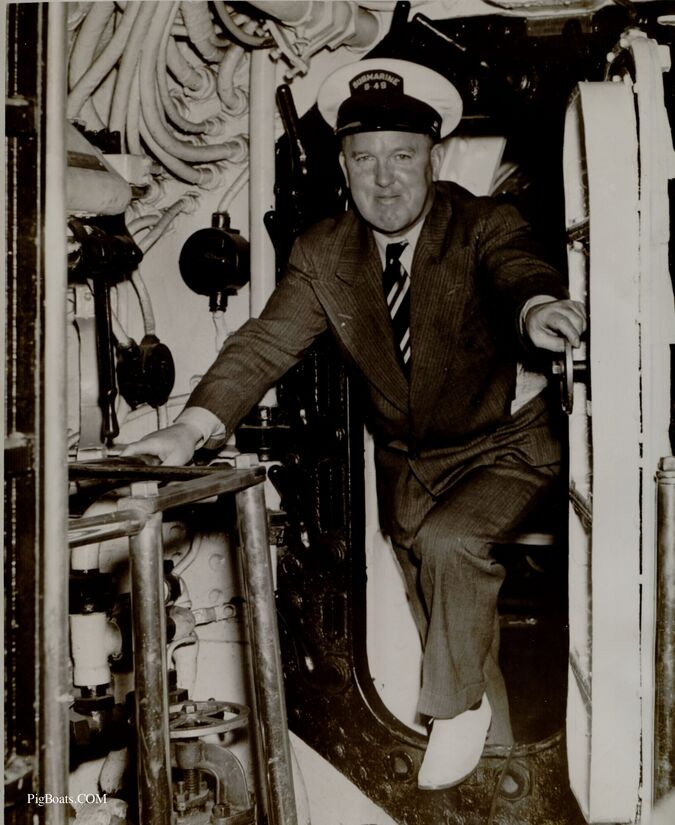S-49 as a civilian exhibit: Difference between revisions
Pbcjohnston (talk | contribs) Added photos |
Pbcjohnston (talk | contribs) m →Notes |
||
| (7 intermediate revisions by 2 users not shown) | |||
| Line 3: | Line 3: | ||
=== <big>Notes</big> === | === <big>Notes</big> === | ||
<div style="text-align: justify;"><span style="color:#00008B">S-49, along with her four near sisters, was never well liked by the Navy. A slow diver with the underwater maneuverability of a laden barge | <div style="text-align: justify;"><span style="color:#00008B">S-49, along with her four near sisters, was never well liked by the Navy. A slow diver with the underwater maneuverability of a laden barge and below average reliability all lead the Navy to decommission the boat in August 1930 and finally strike her from the Navy List in March of 1931. She was sold for scrapping to the Boston Iron & Metal Co. out of Baltimore, but at that point fate stepped in and provided her with a new story. The company apparently "demilitarized" the S-49, but before they started on the final scrapping process they sold the hulk to two gentlemen by the name of William M. Keevey, a business man and local politician from Revere, MA., and Francis J. Chrestensen, who was a ne'er-do-well and something of a huckster and carnival side-show man with a penchant for pursuing the "next big thing". The date of the purchase was July 1, 1931. They saw the S-49 as a potentially lucrative money-making venture so they somehow raised $25,000 to purchase her and refit her as a traveling exhibit. The boat had been rendered incapable of diving by the Boston Iron company, and it removed the batteries and rendered the engines inoperative as well. | ||
At first Chrestensen had her towed to each location, but | At first Chrestensen and Keevey had her towed to each location, but Chrestensen got tired of being derided for it so he had a small diesel engine installed so that she could move her under her own power. She was displayed at a variety of locations throughout the Great Lakes and the New England coast. Chrestensen, his wife, and a small crew actually lived onboard the boat. | ||
As the story goes, Chrestensen | As the story goes, S-49 proved to be a popular attraction, but the owners constantly struggled to pay their debts, skirting bill collectors and creditors. Keevey later left the venture, with Chrestensen continuing alone. Unfortunately, at one point he and his wife entered into a bitter divorce, and after a drawn-out court battle Chrestensen lost control and ownership of the S-49. The Navy reacquired the hulk in 1941 "as equipment" for use as a sonar and weapons target at the Naval Mine Warfare Proving Ground, Solomons, Maryland. In the course of this work she sank on December 16, 1942 in 102 feet (31 m) of water just off Point Patience, MD. in the Patuxent River. She remains there to this day. | ||
[[File:Red bar sub new.jpg]] | |||
<center> | |||
<gallery mode="packed" widths="400px" heights="300px"> | |||
File:S-49 mass 1.jpg|<small>Photo in the private collection of Ric Hedman.</small> | |||
File:S-49 mass 2.jpg|<small>Photo in the private collection of Ric Hedman.</small> | |||
File:S-49 mass 3.jpg|<small>National Archives photo.</small> | |||
File:S-49 mass 4.jpg|<small>National Archives photo.</small> | |||
</gallery> | |||
</center> | |||
<div style="text-align: justify;"><span style="color:#00008B">The S-49 "on the hard", aground at Point-Of-Pines in Revere, MA. circa 1932. She is open for business as a tourist exhibit by Keevey and Chrestensen near Keevey's restaurant. | |||
These views show details of the S-49's hull below the water line. The non-retractable bow planes and their guard can clearly be seen, along with the circular plate of the Fessenden Oscillator, an early form of sonar. The fourth photo gives a clear view of the stern torpedo tube. | |||
[[File:Red bar sub new.jpg]] | |||
[[File:S-49 keevey 1931.jpg|left|500px]] | |||
<div style="text-align: justify;"><span style="color:#00008B">An advertisement for Keevey's restaurant. The bow of the S-49 can just be seen on the left. Note that Chrestensen's name is spelled incorrectly. Reportedly he had a penchant for doing this deliberately, for reasons unknown. | |||
<small>National Archive photo with a flier courtesy of Stephen Wilk.</small> | |||
[[File:Red bar sub new.jpg]] | |||
[[File:S-49 open for inspection.jpg|left|500px]] | |||
<div style="text-align: justify;"><span style="color:#00008B">This photo shows S-49 at Washington DC being set up as a tourist attraction on November 1, 1931. She had just arrived from Trenton, NJ, via the Delaware River and the Delaware - Chesapeake Canal, Chesapeake Bay and the Potomac River to arrive at this destination. Her new owner and skipper for this voyage is "Captain" Francis J. Chrestensen. According to a newspaper article the trip was made at six knots but it doesn't say if that was under its own power or under tow. | |||
The sign reads; "Submarine Open For Inspection - Admission 25 cents - Children 15 cents". Chrestensen had hired a large crew of people to do tours and help maintain the submarine. A few of those are seen on the deck. A skiff can be seen lashed to the side of the submarine just to the left and below the conning tower. | |||
<small>Original wire photo in the private collection of Ric Hedman.</small> | |||
[[File:Red bar sub new.jpg]] | |||
[[File:S-49 Montreal.jpg|left|500px]] | |||
<div style="text-align: justify;"><span style="color:#00008B">The S-49, in private ownership, toured the U.S. East Coast and the St. Lawrence River waterway as an exhibition, charging admission for revenue. This photo is dated May 24, 1933 and looking very closed up for business. There seems to be a light haze or fog hanging over the city. | |||
A number of interesting things are seen in the background. The small white building directly behind the submarine is painted in large dark letters, "EKERS India Pale ALE". Ekers was a Montreal brewery. | |||
Keeping in the beers line, over the city skyline and in the center of the photo, is another large sign that reads "Biere BLACK HORSE ALE" that was owned and operated by Dawes, part of National Breweries, and they brewed this favorite in Montreal. The National Breweries was bought out in 1952 by Canadian Breweries. In July 1952, the last Black Horse ale was brewed but due to popular demand it was brought back in 1960. The building directly behind the sign looks to be the Beaver Hall Building built in 1930. | |||
The building at the right seems to be the Banque Royale du Canada or, in English, the Royal Bank of Canada. The tall chimney in front of it has painted HEINZ 57. Whether this is a Heinz plant or just advertising isn't known at this time. | |||
Two days later the submarine had left, bound for Chicago and the World's Fair. On May 26, 1933 newspapers have noted that the submarine ran aground at "Hinkley's Bar", near Carleton Island on the Canadian side of the St. Lawrence River. The reports say that tugs were on hand and were trying to pull it free. The submarine was only a few miles from entering into Lake Ontario at this point. We do not know what time of day or night this may have happened or how well the bar was marked as a hazard. | |||
<small>Photo in the private collection of Ric Hedman.</small> | |||
[[File:Red bar sub new.jpg]] | [[File:Red bar sub new.jpg]] | ||
[[File:S-49 Cleveland.jpg|left|500px]] | [[File:S-49 Cleveland.jpg|left|500px]] | ||
<div style="text-align: justify;"><span style="color:#00008B"> | <div style="text-align: justify;"><span style="color:#00008B">S-49 was towed into the Great Lakes and displayed at the Great Lakes Exposition in Cleveland, OH in 1937. She drew big crowds nearly everywhere she went, but her owners were still unable to make a lot of money. | ||
<small>Photo in the private collection of Ric Hedman.</small> | <small>Photo in the private collection of Ric Hedman.</small> | ||
| Line 19: | Line 64: | ||
[[File:S-49 control room.jpg|left|500px]] | [[File:S-49 control room.jpg|left|500px]] | ||
<div style="text-align: justify;"><span style="color:#00008B"> | <div style="text-align: justify;"><span style="color:#00008B">S-49's control room while in Cleveland. This view shows the two large wheels for operating the bow and stern planes. The two large circular dials are the depth gauges. | ||
<small>Photo in the private collection of Ric Hedman.</small> | <small>Photo in the private collection of Ric Hedman.</small> | ||
| Line 26: | Line 71: | ||
[[File:S-49 engine room.jpg|left|500px]] | [[File:S-49 engine room.jpg|left|500px]] | ||
<div style="text-align: justify;"><span style="color:#00008B"> | <div style="text-align: justify;"><span style="color:#00008B">S-49's engine room during the Cleveland Exposition. While the engine blocks were still present, holes had been drilled in the cylinder heads and pistons while the boat was at the Boston Iron company as part of the effort to demilitarize her. Chrestensen later had a small diesel engine installed in the motor room that provided some form of self-propulsion. | ||
<small>Photo in the private collection of Ric Hedman.</small> | <small>Photo in the private collection of Ric Hedman.</small> | ||
| Line 33: | Line 78: | ||
[[File:S-49 torpedo room.jpg|left|500px]] | [[File:S-49 torpedo room.jpg|left|500px]] | ||
<div style="text-align: justify;"><span style="color:#00008B"> | <div style="text-align: justify;"><span style="color:#00008B">S-49's forward torpedo room during the Cleveland Exposition. One breech door is open. All of the tubes had been rendered incapable of firing torpedoes, and of course during this time none were onboard. | ||
<small>Photo in the private collection of Ric Hedman.</small> | <small>Photo in the private collection of Ric Hedman.</small> | ||
| Line 39: | Line 84: | ||
[[File:Red bar sub new.jpg]] | [[File:Red bar sub new.jpg]] | ||
[[File:S-49 | [[File:S-49 and blimp.jpg|left|500px]] | ||
<div style="text-align: justify;"><span style="color:#00008B"> | <div style="text-align: justify;"><span style="color:#00008B"> | ||
This photo was taken on May 30, 1937, the second day of the Great Lakes Exposition in Cleveland, OH. | |||
A Goodyear blimp is flying overhead advertising Goodyear Tires. The photographer had to crouch down to get the angle for the shot. There is actually an anchor in the mount but it can't be seen being as the whole area, including the anchor, is painted black. Other photos show the anchor. | |||
Note that the American flags seen just over the top of the shear line are at half mast. This was Memorial Day. At noon flags are once again raised to full mast height. So, the photo was taken before noon that day. | |||
<small>Photo in the private collection of Ric Hedman.</small> | <small>Photo in the private collection of Ric Hedman.</small> | ||
| Line 53: | Line 96: | ||
[[File:Red bar sub new.jpg]] | [[File:Red bar sub new.jpg]] | ||
[[File:S-49 | [[File:S-49 windsor.jpg|left|500px]] | ||
<div style="text-align: justify;"><span style="color:#00008B"> | <div style="text-align: justify;"><span style="color:#00008B">During her journey through the Great Lakes, S-49 also stopped in Windsor, Ontario. She is seen here moored to a dock in the Detroit River. Two members of her civilian crew are seen on the forward deck. | ||
<small>Photo in the private collection of Ric Hedman.</small> | <small>Photo in the private collection of Ric Hedman.</small> | ||
| Line 61: | Line 104: | ||
[[File:S-49 Toronto 4-6-38.jpg|left|500px]] | [[File:S-49 Toronto 4-6-38.jpg|left|500px]] | ||
<div style="text-align: justify;"><span style="color:#00008B"> | <div style="text-align: justify;"><span style="color:#00008B">S-49 alongside a pier in Toronto during the 1937 Great Lakes journey. Note the small black letter "C" on her superstructure just forward of the "S 49". In order to skirt Canadian laws about having military vessels in Great Lakes ports, Chrestensen had her registered as "Yacht C". | ||
<small>Photo in the private collection of Ric Hedman.</small> | <small>Photo in the private collection of Ric Hedman.</small> | ||
| Line 67: | Line 110: | ||
[[File:Red bar sub new.jpg]] | [[File:Red bar sub new.jpg]] | ||
[[File:S-49 | [[File:S-49 texaco-May 30 1937.jpg|left|500px]] | ||
<div style="text-align: justify;"><span style="color:#00008B"> | <div style="text-align: justify;"><span style="color:#00008B"> | ||
The decommissioned submarine S-49 seen moored to the docks at a "The Texas Company" facility, most likely in Miami, Florida. F. J. Chrestensen, who purchased the submarine from Boston Iron and Metal Co. in Baltimore, Md. had his residence in Jacksonville, Fla. It would be a logical location to exhibit the submarine. The Texas Company was to become TEXACO. The first oil company to have locations in all of the US states. | |||
Seen just above the buildings in the center of the photo is a blimp. We can not tell if it is a civilian or Navy airship from this photo. | |||
<small>Photo in the private collection of Ric Hedman.</small> | <small>Photo in the private collection of Ric Hedman.</small> | ||
| Line 74: | Line 120: | ||
[[File:Red bar sub new.jpg]] | [[File:Red bar sub new.jpg]] | ||
[[File:S-49 | [[File:S-49 Miami 2.jpg|left|500px]] | ||
<div style="text-align: justify;"><span style="color:#00008B"> | <div style="text-align: justify;"><span style="color:#00008B">Another view of the the former S-49, identified as being on the causeway to Miami Beach, most likely at The Texas Company docks. Just a hint of a palm tree can be seen at the right edge. | ||
The shore side railings are lined with large pictures, some of which show a submarine. The photos are probably designed to entice people aboard and tour the submarine. The man on deck may be Chrestensen, he does seem to be wearing some sort of an "official" looking uniform. Note loudspeakers on top of the conning tower bridge. There is a blimp just above the flag on the back of the submarine. | |||
<small>Photo in the private collection of Ric Hedman.</small> | <small>Photo in the private collection of Ric Hedman.</small> | ||
| Line 81: | Line 129: | ||
[[File:Red bar sub new.jpg]] | [[File:Red bar sub new.jpg]] | ||
[[File:S-49 | [[File:S-49 1938 May 30.jpg|left|500px]] | ||
<div style="text-align: justify;"><span style="color:#00008B"> | <div style="text-align: justify;"><span style="color:#00008B">A later photo of the former S-49, either at Trenton, NJ or at Washington, DC. In 1939 the submarine traveled from Trenton, New Jersey to the Navy Yard via the Delaware River and Delaware-Chesapeake Canal. | ||
She is moored in this photo and men and women are seen on the deck. Several men in "uniforms" are also visible but it is unknown if these are Navy Officers or submarine "crew" which were dressed in a uniform style. | |||
A photo placard is attached to the railing facing the dock showing a torpedoed tanker from WW I. | |||
<small>Photo in the private collection of Ric Hedman.</small> | <small>Photo in the private collection of Ric Hedman.</small> | ||
| Line 89: | Line 141: | ||
[[File:S-49 Fairwater Delaware River 1939.jpg|left|500px]] | [[File:S-49 Fairwater Delaware River 1939.jpg|left|500px]] | ||
<div style="text-align: justify;"><span style="color:#00008B"> | <div style="text-align: justify;"><span style="color:#00008B">A photo from a different angle during the visit in the Delaware and Potomac Rivers in 1939. | ||
<small>Photo in the private collection of Ric Hedman.</small> | <small>Photo in the private collection of Ric Hedman.</small> | ||
| Line 95: | Line 147: | ||
[[File:Red bar sub new.jpg]] | [[File:Red bar sub new.jpg]] | ||
[[File:S-49 Delaware River 1939 David A Boone.jpg|left|500px]] | |||
<div style="text-align: justify;"><span style="color:#00008B">S-49 in the Delaware River in 1939. The small enclosure on her stern was not original equipment. It was a small pilothouse built by Chrestensen's crew so that they could operate the small diesel engine that they had installed in the motor room. They also steered the boat from here, which must have been an awkward arrangement. | |||
File:S-49 | |||
<div style="text-align: justify;"><span style="color:#00008B"> | |||
<small>Photo | <small>Photo courtesy of David A. Boone, via Navsource.</small> | ||
[[File:Red bar sub new.jpg]] | [[File:Red bar sub new.jpg]] | ||
[[File:S-49 | [[File:S-49 crowds.jpg|left|500px]] | ||
<div style="text-align: justify;"><span style="color:#00008B"> | <div style="text-align: justify;"><span style="color:#00008B">The old S-49 certainly got around in her civilian days. Crowds toured the S-49 by the thousands at the 1939 Chicago World's Fair. The cost was 25¢ per adult and 15¢ for children. These could have been profitable days for the sub's touring business. | ||
<small>Photo in the private collection of Ric Hedman.</small> | <small>Photo in the private collection of Ric Hedman.</small> | ||
[[File:Red bar sub new.jpg]] | [[File:Red bar sub new.jpg]] | ||
<center> | <center> | ||
<gallery mode="packed" widths=" | <gallery mode="packed" widths="450px" heights="550px"> | ||
File:S-49 | File:S-49 francis crestensen-C.jpg | ||
File:S-49 francis crestensen-D.jpg | |||
File:S-49 | |||
</gallery> | </gallery> | ||
</center> | </center> | ||
<div style="text-align: justify;"><span style="color:#00008B"> | <div style="text-align: justify;"><span style="color:#00008B">Two views of Francis J. Chrestensen aboard the S-49. While his persistence was admirable, he was one of those prototypical Depression-era hucksters, always looking for the next big thing, skirting the edges of being a con-man. He was a shameless self-promoter with a hundred-gallon ego. Despite making some money with the S-49, he was not much of a businessman and eventually lost control of the boat during bitter divorce proceedings with his wife. | ||
<small>Photos in the private collection of Ric Hedman.</small> | |||
<small> | |||
[[File:Red bar sub new.jpg]] | [[File:Red bar sub new.jpg]] | ||
[[File:S-49 Chrestensen Gravestone.jpg|left|500px]] | [[File:S-49 Chrestensen Gravestone.jpg|left|500px]] | ||
<div style="text-align: justify;"><span style="color:#00008B"> | <div style="text-align: justify;"><span style="color:#00008B">Chrestensen's attachment to the S-49 becomes quite apparent here, with his bigger than life personality showing through. Most Navy veterans would look askance at how he wanted to be remembered, but to each his own. | ||
<small>Photo in the private collection of Ric Hedman.</small> | <small>Photo in the private collection of Ric Hedman.</small> | ||
Latest revision as of 13:42, 2 March 2024
Notes
At first Chrestensen and Keevey had her towed to each location, but Chrestensen got tired of being derided for it so he had a small diesel engine installed so that she could move her under her own power. She was displayed at a variety of locations throughout the Great Lakes and the New England coast. Chrestensen, his wife, and a small crew actually lived onboard the boat.
As the story goes, S-49 proved to be a popular attraction, but the owners constantly struggled to pay their debts, skirting bill collectors and creditors. Keevey later left the venture, with Chrestensen continuing alone. Unfortunately, at one point he and his wife entered into a bitter divorce, and after a drawn-out court battle Chrestensen lost control and ownership of the S-49. The Navy reacquired the hulk in 1941 "as equipment" for use as a sonar and weapons target at the Naval Mine Warfare Proving Ground, Solomons, Maryland. In the course of this work she sank on December 16, 1942 in 102 feet (31 m) of water just off Point Patience, MD. in the Patuxent River. She remains there to this day.
-
Photo in the private collection of Ric Hedman.
-
Photo in the private collection of Ric Hedman.
-
National Archives photo.
-
National Archives photo.
These views show details of the S-49's hull below the water line. The non-retractable bow planes and their guard can clearly be seen, along with the circular plate of the Fessenden Oscillator, an early form of sonar. The fourth photo gives a clear view of the stern torpedo tube.
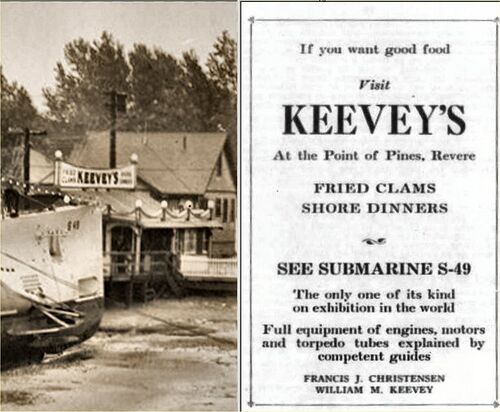
National Archive photo with a flier courtesy of Stephen Wilk.
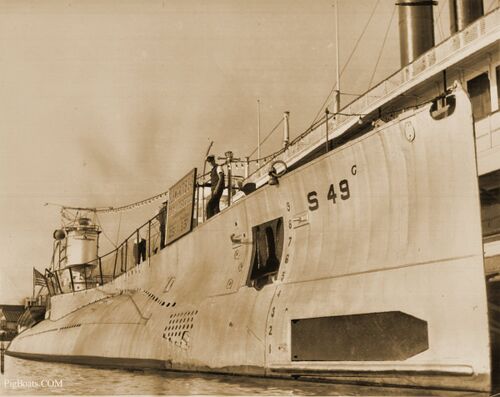
The sign reads; "Submarine Open For Inspection - Admission 25 cents - Children 15 cents". Chrestensen had hired a large crew of people to do tours and help maintain the submarine. A few of those are seen on the deck. A skiff can be seen lashed to the side of the submarine just to the left and below the conning tower.
Original wire photo in the private collection of Ric Hedman.
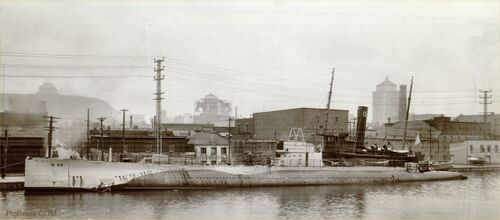
A number of interesting things are seen in the background. The small white building directly behind the submarine is painted in large dark letters, "EKERS India Pale ALE". Ekers was a Montreal brewery.
Keeping in the beers line, over the city skyline and in the center of the photo, is another large sign that reads "Biere BLACK HORSE ALE" that was owned and operated by Dawes, part of National Breweries, and they brewed this favorite in Montreal. The National Breweries was bought out in 1952 by Canadian Breweries. In July 1952, the last Black Horse ale was brewed but due to popular demand it was brought back in 1960. The building directly behind the sign looks to be the Beaver Hall Building built in 1930.
The building at the right seems to be the Banque Royale du Canada or, in English, the Royal Bank of Canada. The tall chimney in front of it has painted HEINZ 57. Whether this is a Heinz plant or just advertising isn't known at this time.
Two days later the submarine had left, bound for Chicago and the World's Fair. On May 26, 1933 newspapers have noted that the submarine ran aground at "Hinkley's Bar", near Carleton Island on the Canadian side of the St. Lawrence River. The reports say that tugs were on hand and were trying to pull it free. The submarine was only a few miles from entering into Lake Ontario at this point. We do not know what time of day or night this may have happened or how well the bar was marked as a hazard.
Photo in the private collection of Ric Hedman.
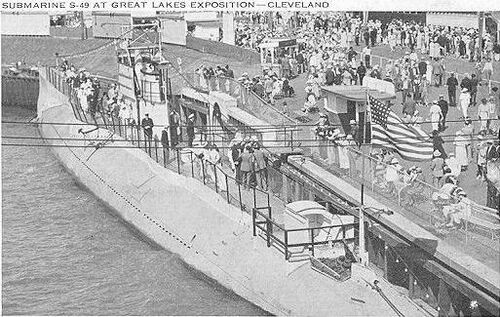
Photo in the private collection of Ric Hedman.
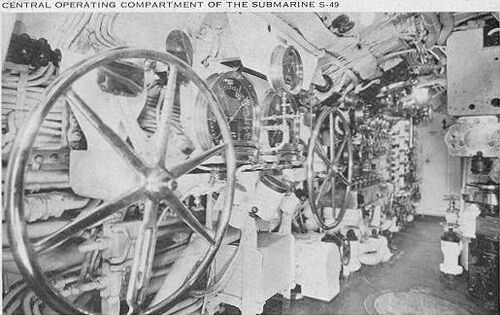
Photo in the private collection of Ric Hedman.
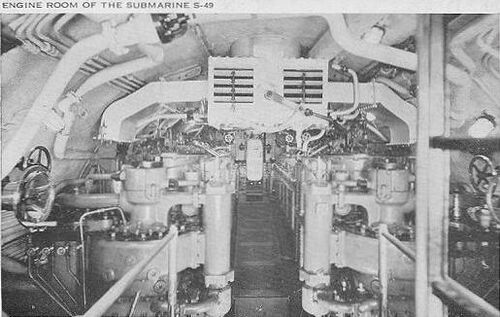
Photo in the private collection of Ric Hedman.
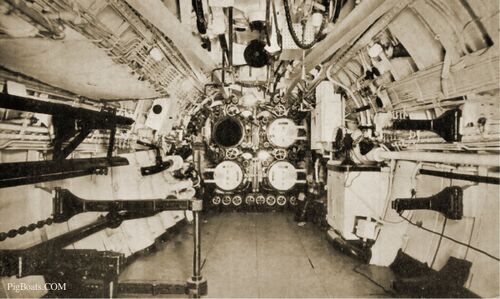
Photo in the private collection of Ric Hedman.
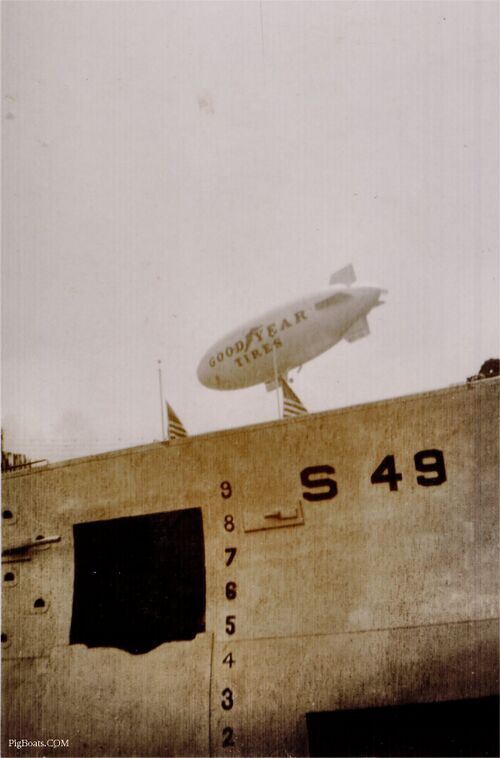
This photo was taken on May 30, 1937, the second day of the Great Lakes Exposition in Cleveland, OH.
A Goodyear blimp is flying overhead advertising Goodyear Tires. The photographer had to crouch down to get the angle for the shot. There is actually an anchor in the mount but it can't be seen being as the whole area, including the anchor, is painted black. Other photos show the anchor.
Note that the American flags seen just over the top of the shear line are at half mast. This was Memorial Day. At noon flags are once again raised to full mast height. So, the photo was taken before noon that day.
Photo in the private collection of Ric Hedman.
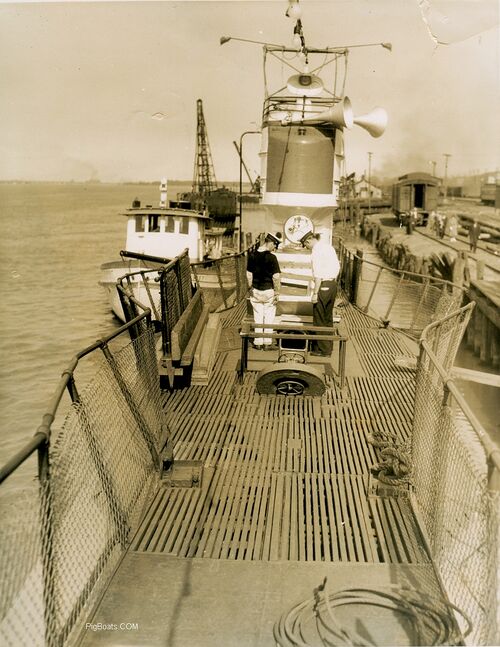
Photo in the private collection of Ric Hedman.
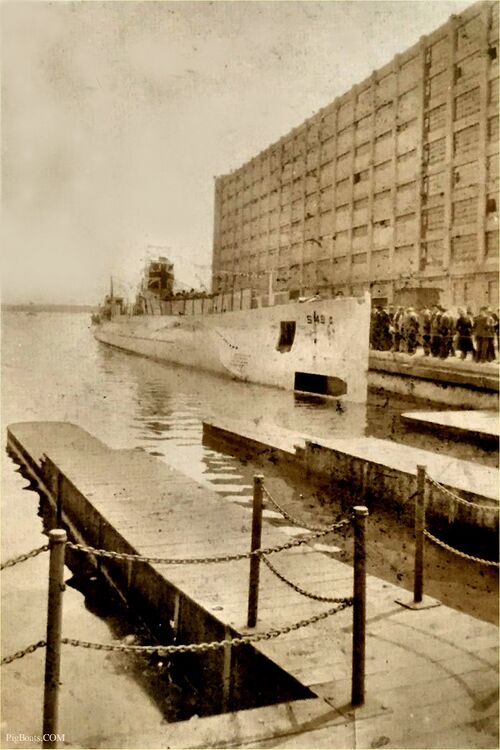
Photo in the private collection of Ric Hedman.

The decommissioned submarine S-49 seen moored to the docks at a "The Texas Company" facility, most likely in Miami, Florida. F. J. Chrestensen, who purchased the submarine from Boston Iron and Metal Co. in Baltimore, Md. had his residence in Jacksonville, Fla. It would be a logical location to exhibit the submarine. The Texas Company was to become TEXACO. The first oil company to have locations in all of the US states.
Seen just above the buildings in the center of the photo is a blimp. We can not tell if it is a civilian or Navy airship from this photo.
Photo in the private collection of Ric Hedman.
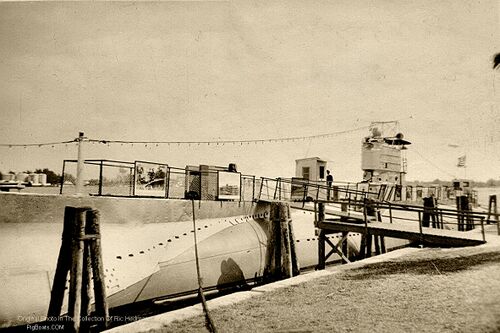
The shore side railings are lined with large pictures, some of which show a submarine. The photos are probably designed to entice people aboard and tour the submarine. The man on deck may be Chrestensen, he does seem to be wearing some sort of an "official" looking uniform. Note loudspeakers on top of the conning tower bridge. There is a blimp just above the flag on the back of the submarine.
Photo in the private collection of Ric Hedman.

She is moored in this photo and men and women are seen on the deck. Several men in "uniforms" are also visible but it is unknown if these are Navy Officers or submarine "crew" which were dressed in a uniform style.
A photo placard is attached to the railing facing the dock showing a torpedoed tanker from WW I.
Photo in the private collection of Ric Hedman.
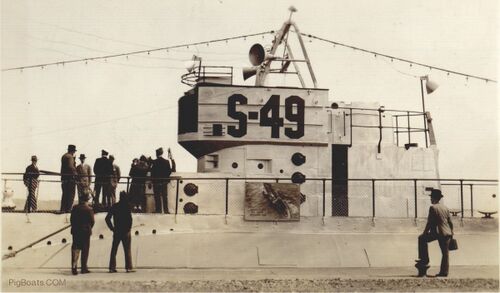
Photo in the private collection of Ric Hedman.

Photo courtesy of David A. Boone, via Navsource.
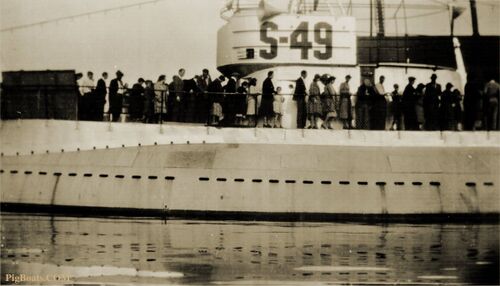
Photo in the private collection of Ric Hedman.
Photos in the private collection of Ric Hedman.
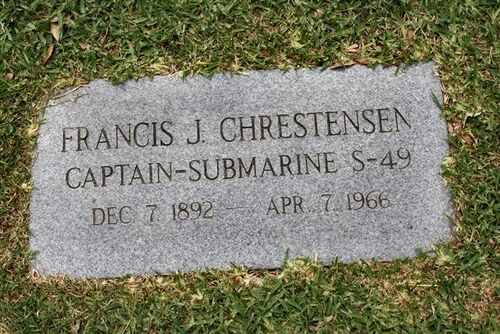
Photo in the private collection of Ric Hedman.
Page created by:
Ric Hedman & David Johnston
1999 - 2023 - PigBoats.COM©
Mountlake Terrace, WA, Norfolk, VA
webmaster at pigboats dot com

